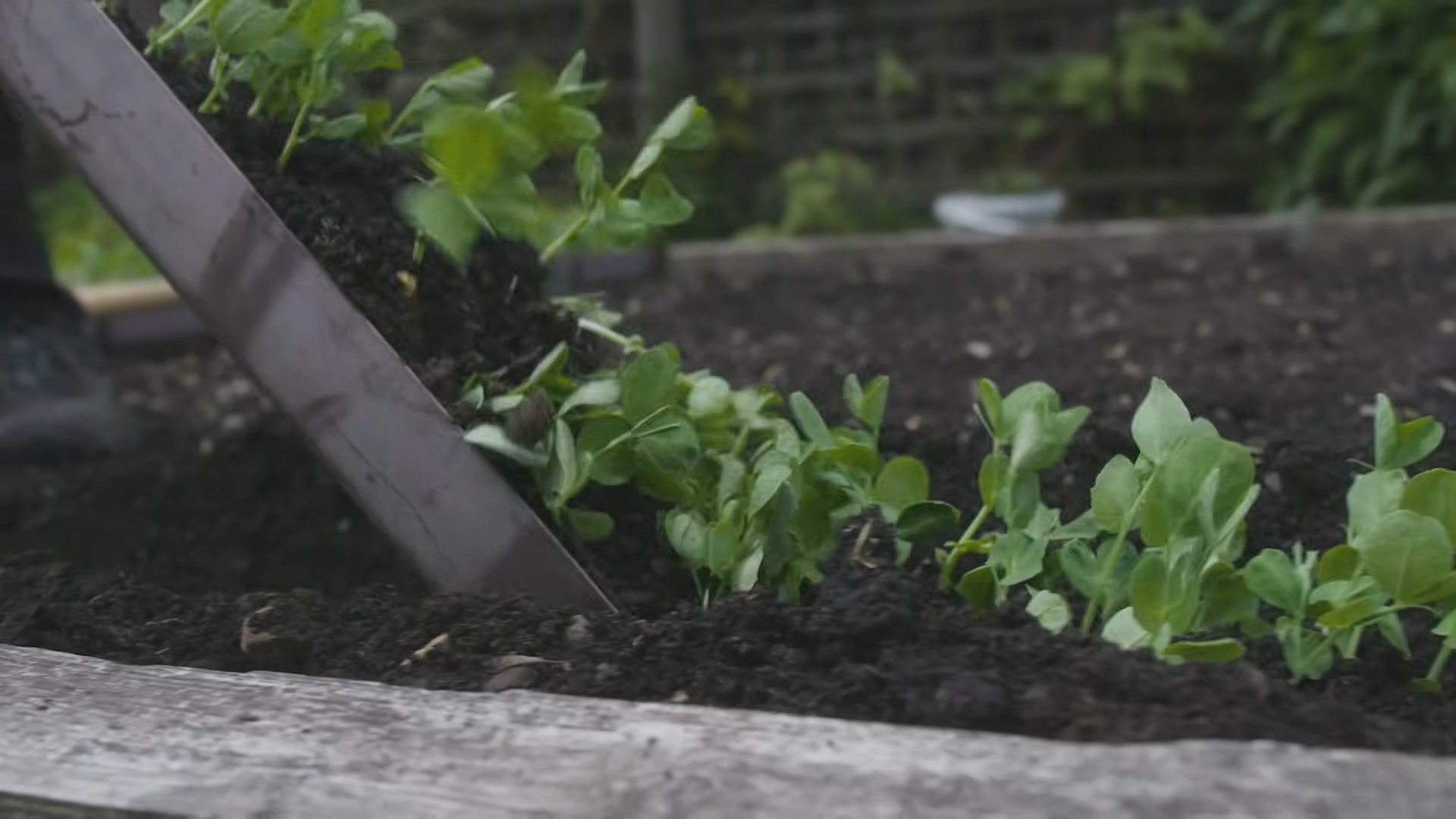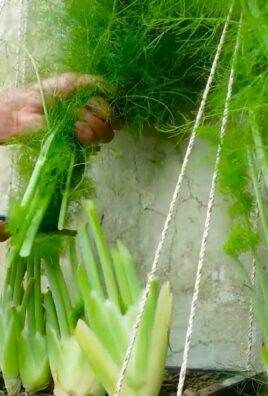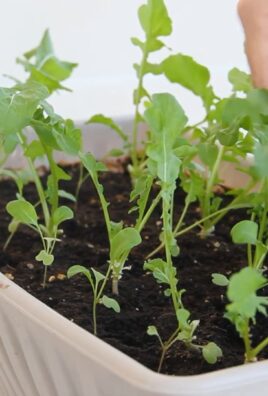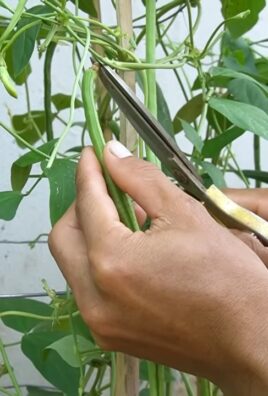Growing Peas Indoors might sound like a challenge, but trust me, it’s a rewarding experience that brings a touch of spring right into your home, even when the weather outside is less than inviting! For centuries, humans have cultivated peas, with evidence suggesting their cultivation dates back to the Neolithic era. From humble garden plots to royal greenhouses, peas have nourished and delighted us. But what if you don’t have a garden? Or perhaps you live in an area with a short growing season? That’s where the magic of indoor gardening comes in!
I know what you’re thinking: “Can I really grow peas inside?” Absolutely! And this DIY guide is here to show you how. Imagine harvesting fresh, sweet pea pods right from your windowsill, adding a burst of flavor to your salads and stir-fries. It’s not just about the taste; it’s about the joy of nurturing life, connecting with nature, and adding a vibrant green touch to your living space. Plus, growing peas indoors is a fantastic way to extend your growing season and enjoy these delicious legumes year-round. So, let’s ditch the store-bought peas and embark on this exciting indoor gardening adventure together!

Growing Peas Indoors: A Complete DIY Guide
Hey there, fellow gardening enthusiasts! Dreaming of fresh, sweet peas even when the weather outside is frightful? Well, you’re in luck! Growing peas indoors is totally achievable, and I’m here to walk you through every step. Get ready to enjoy homegrown goodness, no matter the season!
Choosing the Right Pea Variety
Not all pea varieties are created equal when it comes to indoor growing. We need to pick ones that are compact and don’t require a ton of space. Here’s what I recommend:
* Bush Peas: These are your best bet! They stay relatively small and don’t need trellising. Look for varieties like ‘Little Marvel,’ ‘Tom Thumb,’ or ‘Sugar Ann.’
* Dwarf Varieties: Similar to bush peas, dwarf varieties are bred to be compact. ‘Mighty Midget’ is a popular choice.
* Avoid Vining Peas: While you *can* grow vining peas indoors, they require significant support and space. Unless you have a dedicated indoor garden setup, stick with bush or dwarf varieties.
Gathering Your Supplies
Before we get our hands dirty, let’s make sure we have everything we need. This is my go-to list:
* Pea Seeds: Obviously! Choose your preferred bush or dwarf variety.
* Containers: I recommend pots that are at least 6 inches deep and wide. This gives the pea plants enough room for their roots to grow. You can use plastic pots, terracotta pots, or even repurposed containers like yogurt tubs (just make sure they have drainage holes!).
* Potting Mix: Use a high-quality, well-draining potting mix. Avoid using garden soil, as it can compact and not drain properly in containers.
* Grow Lights (Optional but Recommended): Peas need a lot of light, especially indoors. If you don’t have a super sunny window, grow lights will be your best friend.
* Watering Can or Spray Bottle: For gentle watering.
* Small Trellis or Stakes (Optional): Even bush peas can benefit from a little support, especially as they start producing pods.
* Seed Starting Tray (Optional): You can start your seeds in a seed starting tray for better germination rates.
* Spray Bottle with Water: For misting seedlings.
Planting Your Pea Seeds
Alright, let’s get planting! This is the fun part.
1. Soak the Seeds (Optional): Soaking your pea seeds in water for 24 hours before planting can help speed up germination. I usually do this, but it’s not strictly necessary.
2. Fill Your Containers: Fill your containers with potting mix, leaving about an inch of space at the top.
3. Sow the Seeds: Make small holes about 1 inch deep and 2 inches apart. Place 2-3 seeds in each hole. This increases your chances of at least one seed germinating in each spot.
4. Cover the Seeds: Gently cover the seeds with potting mix.
5. Water Thoroughly: Water the soil gently until it’s evenly moist but not soggy.
6. Label Your Pots: Don’t forget to label your pots with the pea variety and the date you planted them!
Germination and Early Growth
Now comes the waiting game! But don’t worry, it won’t be long before you see those little sprouts popping up.
1. Maintain Moisture: Keep the soil consistently moist but not waterlogged. Check the soil moisture daily and water as needed.
2. Provide Warmth: Pea seeds germinate best in temperatures between 60-70°F (15-21°C).
3. Provide Light: Once the seedlings emerge, they need plenty of light. Place them in a sunny window that receives at least 6 hours of direct sunlight per day. If you’re using grow lights, position them a few inches above the seedlings and keep them on for 14-16 hours per day.
4. Thin Seedlings (If Necessary): If more than one seed germinated in each spot, thin them out by snipping off the weaker seedlings at the soil line. Leave the strongest seedling in each spot.
Caring for Your Indoor Pea Plants
Once your pea plants are established, it’s time to focus on providing them with the care they need to thrive.
1. Watering: Water your pea plants regularly, keeping the soil consistently moist but not soggy. Overwatering can lead to root rot, so be careful not to overdo it. I usually water when the top inch of soil feels dry to the touch.
2. Fertilizing: Peas are relatively light feeders, but they will benefit from occasional fertilization. Use a balanced liquid fertilizer diluted to half strength every 2-3 weeks.
3. Providing Support: Even bush peas can get a little floppy as they grow and start producing pods. Providing them with some support will help keep them upright and prevent them from falling over. You can use small trellises, stakes, or even just some twine tied to a support.
4. Pest Control: Keep an eye out for common pests like aphids and spider mites. If you spot any pests, you can try spraying them with insecticidal soap or neem oil.
5. Pollination: Peas are self-pollinating, so you don’t need to worry about hand-pollinating them. However, you can give them a little boost by gently shaking the plants every few days to help release pollen.
Harvesting Your Peas
The moment we’ve all been waiting for! Harvesting your own homegrown peas is incredibly rewarding.
1. Harvest Time: Peas are typically ready to harvest about 60-70 days after planting. The pods should be plump and filled with peas.
2. Harvesting Technique: Gently snap the pods off the plant. Be careful not to damage the plant while harvesting.
3. Harvest Regularly: Harvest your peas regularly to encourage the plant to produce more pods.
4. Enjoy Your Harvest: Eat your peas fresh, or store them in the refrigerator for a few days. You can also freeze them for longer storage.
Troubleshooting Common Problems
Even with the best care, you might encounter some problems while growing peas indoors. Here are a few common issues and how to address them:
* Poor Germination: If your pea seeds aren’t germinating, make sure the soil is warm enough and consistently moist. You can also try scarifying the seeds by gently scratching the outer coating before planting.
* Leggy Seedlings: Leggy seedlings are tall and spindly, usually due to insufficient light. Make sure your seedlings are getting enough light, either from a sunny window or grow lights.
* Yellowing Leaves: Yellowing leaves can be a sign of overwatering, underwatering, or nutrient deficiency. Check the soil moisture and adjust your watering accordingly. You can also try fertilizing your plants with a balanced fertilizer.
* Lack of Pods: If your pea plants are growing well but not producing pods, it could be due to insufficient light or pollination problems. Make sure your plants are getting enough light and try gently shaking them every few days to help release pollen.
Extending Your Harvest
Want to keep the pea party going? Here are a few tips for extending your harvest:
* Succession Planting: Plant a new batch of pea seeds every 2-3 weeks to ensure a continuous harvest.
* Choose Heat-Tolerant Varieties: If you’re growing peas during the warmer months, choose heat-tolerant varieties that are less likely to bolt (go to seed).
* Provide Shade: During the hottest part of the day, provide your pea plants with some shade to protect them from the intense sun.
Section: Advanced Techniques for Indoor Pea Growing
Want to take your indoor pea growing to the next level? Here are a few advanced techniques to try:
* Hydroponics: Growing peas hydroponically can result in faster growth and higher yields. There are many different hydroponic systems you can use, such as deep water culture, nutrient film technique, and ebb and flow.
* Vertical Gardening: If you’re short on space, consider growing your peas vertically using a trellis or other support structure. This can help maximize your growing area and create a beautiful green wall.
* Companion Planting: Planting certain herbs and vegetables alongside your peas can help improve their growth and protect them from pests. Good companion plants for peas include carrots, radishes, and rosemary.
Section: Saving Pea Seeds for Next Year
If you want to save money and grow your own pea seeds, it’s relatively easy to do. Here’s how:
1. Choose Healthy Plants: Select the healthiest and most productive pea plants to save seeds from.
2. Allow Pods to Mature: Allow some of the pods to fully mature on the plant. The pods will turn

Conclusion
So, there you have it! Growing peas indoors is not only possible, but it’s also a surprisingly rewarding experience. Forget relying solely on grocery store produce or waiting for the perfect outdoor conditions. With this simple DIY trick, you can enjoy fresh, tender pea shoots and even edible pea pods right from the comfort of your own home, all year round.
Why is this a must-try? Think about it: you’re gaining access to incredibly fresh, nutrient-rich greens that are bursting with flavor. Pea shoots are fantastic in salads, stir-fries, or even as a garnish for soups. Plus, the process itself is incredibly therapeutic. Watching those tiny seeds sprout and grow into vibrant plants is a truly satisfying experience, especially during the colder months when outdoor gardening is limited. It’s a little slice of spring right in your kitchen!
Beyond the basic method, there are plenty of ways to customize your indoor pea-growing adventure. Experiment with different varieties of peas. Snow peas, sugar snap peas, and shelling peas all have slightly different flavors and textures. You can also try using different types of containers. While we’ve focused on using trays, you could also use pots, hanging baskets, or even repurposed containers like plastic tubs. Just make sure whatever you choose has adequate drainage.
Another fun variation is to experiment with different growing mediums. While soil works perfectly well, you could also try using soilless mixes like coco coir or perlite. These mediums can provide excellent drainage and aeration, which can be beneficial for pea growth. You can even try hydroponics for a more advanced approach!
Don’t be afraid to get creative with your setup. If you don’t have a sunny windowsill, you can use grow lights to provide the necessary light for your peas. You can also use a fan to improve air circulation and prevent fungal diseases.
The beauty of this DIY trick is its simplicity and adaptability. It’s a project that anyone can undertake, regardless of their gardening experience. And the rewards – fresh, delicious peas and a sense of accomplishment – are well worth the effort.
We wholeheartedly encourage you to give this indoor pea-growing method a try. It’s a fantastic way to connect with nature, enjoy fresh produce, and add a touch of green to your home. Once you’ve experienced the joy of harvesting your own homegrown peas, you’ll be hooked!
And most importantly, we want to hear about your experiences! Share your photos, tips, and tricks in the comments below. Let us know what varieties of peas you’ve tried, what challenges you’ve faced, and what successes you’ve achieved. Together, we can create a community of indoor pea-growing enthusiasts and learn from each other’s experiences. So, grab some pea seeds, get your hands dirty, and start growing your own delicious peas indoors today! This simple DIY trick will transform your kitchen into a mini-garden.
Frequently Asked Questions (FAQ)
What kind of peas are best for growing indoors?
Generally, bush varieties of peas are better suited for indoor growing than vining varieties, as they require less support and space. However, you can still grow vining varieties indoors if you provide them with a trellis or other support structure. Popular choices include:
* **Dwarf Grey Sugar:** A compact variety that produces sweet, edible pods.
* **Snowbird:** A bush-type snow pea that’s known for its early maturity and high yields.
* **Little Marvel:** A classic shelling pea that’s easy to grow and produces delicious peas.
* **Oregon Sugar Pod II:** A popular snow pea variety that’s known for its disease resistance.
* **Sugar Ann:** An early-maturing snap pea that’s perfect for snacking.
Ultimately, the best variety for you will depend on your personal preferences and growing conditions. Experiment with different varieties to see which ones thrive in your indoor environment.
How much light do indoor peas need?
Peas need at least 6-8 hours of direct sunlight per day to thrive. If you don’t have a sunny windowsill, you can supplement with grow lights. Position the grow lights about 6-12 inches above the plants and keep them on for 12-16 hours per day. LED grow lights are a great option as they are energy-efficient and produce very little heat. Insufficient light will result in leggy, weak plants with poor yields.
How often should I water my indoor peas?
Keep the soil consistently moist, but not waterlogged. Water when the top inch of soil feels dry to the touch. Overwatering can lead to root rot, so make sure your containers have adequate drainage. The frequency of watering will depend on factors such as the temperature, humidity, and type of container you’re using. Check the soil moisture regularly and adjust your watering schedule accordingly.
What kind of soil should I use for growing peas indoors?
Use a well-draining potting mix that’s rich in organic matter. You can also amend your potting mix with compost or other organic materials to improve its fertility. Avoid using garden soil, as it can be too heavy and may contain pests or diseases. A good potting mix will provide the necessary nutrients and drainage for healthy pea growth.
How long does it take for peas to germinate indoors?
Pea seeds typically germinate within 7-14 days, depending on the temperature and moisture levels. To speed up germination, you can soak the seeds in water for 24 hours before planting. Keep the soil consistently moist during the germination period.
When can I harvest my indoor peas?
The harvest time will depend on the variety of peas you’re growing. Pea shoots can be harvested as soon as they’re a few inches tall, typically within 2-3 weeks of planting. Edible pods (snow peas and sugar snap peas) can be harvested when they’re plump and tender, usually within 60-70 days. Shelling peas can be harvested when the pods are full and the peas inside are mature, typically within 60-75 days.
How do I prevent pests and diseases from affecting my indoor peas?
To prevent pests and diseases, start with clean containers and potting mix. Ensure good air circulation by using a fan or opening a window. Inspect your plants regularly for signs of pests or diseases. If you find any pests, you can try washing them off with soapy water or using insecticidal soap. For fungal diseases, you can try using a fungicide or improving air circulation.
Can I grow peas indoors year-round?
Yes, you can grow peas indoors year-round, as long as you provide them with adequate light, water, and nutrients. Indoor growing allows you to control the environment and avoid the challenges of outdoor gardening, such as pests, diseases, and unfavorable weather conditions.
Do I need to fertilize my indoor peas?
Peas are relatively light feeders, but they can benefit from occasional fertilization. Use a balanced liquid fertilizer diluted to half strength every 2-3 weeks. Avoid over-fertilizing, as this can lead to excessive foliage growth and reduced yields.
My pea plants are growing tall and leggy. What should I do?
Leggy growth is usually a sign of insufficient light. Move your plants to a sunnier location or supplement with grow lights. You can also prune the plants back to encourage bushier growth. Make sure to provide adequate support for vining varieties to prevent them from falling over.





Leave a Comment